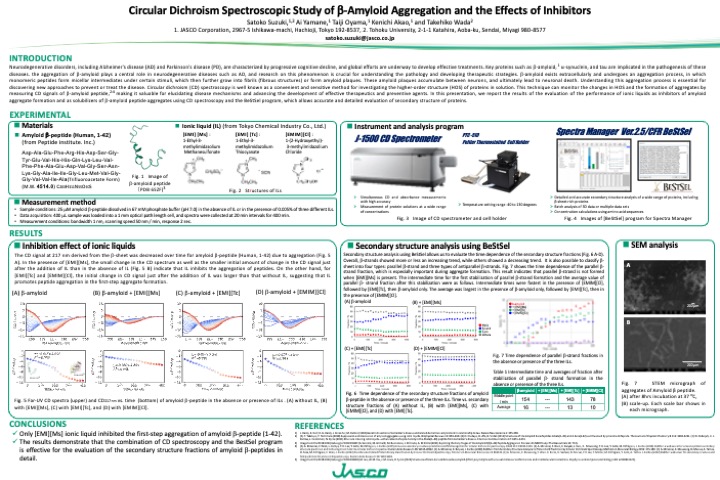Circular Dichroism Spectroscopic Study of b-Amyloid Aggregation and the Effects of Inhibitors | POSTER
Introduction
 Neurodegenerative disorders, including Alzheimer’s disease (AD) and Parkinson’s disease (PD), are characterized by progressive cognitive decline, and global efforts are underway to develop effective treatments. Key proteins such as β-amyloid, 1 a-synuclein, and tau are implicated in the pathogenesis of these diseases. the aggregation of β-amyloid plays a central role in neurodegenerative diseases such as AD, and research on this phenomenon is crucial for understanding the pathology and developing therapeutic strategies. β-amyloid exists extracellularly and undergoes an aggregation process, in which monomeric peptides form micellar intermediates under certain stimuli, which then further grow into fibrils (fibrous structures) or form amyloid plaques. These amyloid plaques accumulate between neurons, and ultimately lead to neuronal death. Understanding this aggregation process is essential for discovering new approaches to prevent or treat the disease. Circular dichroism (CD) spectroscopy is well known as a convenient and sensitive method for investigating the higher-order structure (HOS) of proteins in solution. This technique can monitor the changes in HOS and the formation of aggregates by measuring CD signals of β-amyloid peptide,2-4 making it valuable for elucidating disease mechanisms and advancing the development of effective therapeutics and preventive agents. In this presentation, we report the results of the evaluation of the performance of ionic liquids as inhibitors of amyloid aggregate formation and as solubilizers of β-amyloid peptide aggregates using CD spectroscopy and the BeStSel program, which allows accurate and detailed evaluation of secondary structure of proteins.
Neurodegenerative disorders, including Alzheimer’s disease (AD) and Parkinson’s disease (PD), are characterized by progressive cognitive decline, and global efforts are underway to develop effective treatments. Key proteins such as β-amyloid, 1 a-synuclein, and tau are implicated in the pathogenesis of these diseases. the aggregation of β-amyloid plays a central role in neurodegenerative diseases such as AD, and research on this phenomenon is crucial for understanding the pathology and developing therapeutic strategies. β-amyloid exists extracellularly and undergoes an aggregation process, in which monomeric peptides form micellar intermediates under certain stimuli, which then further grow into fibrils (fibrous structures) or form amyloid plaques. These amyloid plaques accumulate between neurons, and ultimately lead to neuronal death. Understanding this aggregation process is essential for discovering new approaches to prevent or treat the disease. Circular dichroism (CD) spectroscopy is well known as a convenient and sensitive method for investigating the higher-order structure (HOS) of proteins in solution. This technique can monitor the changes in HOS and the formation of aggregates by measuring CD signals of β-amyloid peptide,2-4 making it valuable for elucidating disease mechanisms and advancing the development of effective therapeutics and preventive agents. In this presentation, we report the results of the evaluation of the performance of ionic liquids as inhibitors of amyloid aggregate formation and as solubilizers of β-amyloid peptide aggregates using CD spectroscopy and the BeStSel program, which allows accurate and detailed evaluation of secondary structure of proteins.
References
1)J. Hardy, K. Duff, K. G. Hardy, J. Perez-Tur, M. Hutton (1998) Genetic dissection of Alzheimer‘s disease and related dementias: amyloid and its relationship to tau. Nature Neuroscience 1: 355-358.
2)(A) T. Takekiyo, Y. Yoshimura (2018) Suppression and dissolution of amyloid aggregates using ionic liquids. Biophysical Reviews 10: 853–860. (B) O. Oludayo, O. Afe, B. Strdel (2012) Structures of the Amyloid beta-Peptides A beta(1-40) and A beta(1-42) as Influenced by pH and a D-Peptide. The Journal of Physical Chemistry B 116: 3280-3291. (C) N. Debeljuh, C. J. Barrow, L. Henderson, N. Byrne (2011) Structure inducing ionic liquids—enhancement of alpha helicity in the Abeta(1–40) peptide from Alzheimer’s disease. Chemical Communications 47: 6371–6373.
3)Image from the RCSB PDB (rcsb.org) of PDB ID 6SZF (A. Santoro, M. Grimaldi, M. Buonocore, I. Stillitano, A. M D’Ursi (2021) Exploring the Early Stages of the Amyloid Aβ(1–42) Peptide Aggregation Process: An NMR Study. Pharmaceuticals 14: 732).
4)(A) A. Micsonai, F. Wien, L. Kernya, Y. H. Lee, Y. Goto, M. Réfrégiers, J. Kardos (2015) Accurate secondary structure prediction and fold recognition for circular dichroism spectroscopy. PNAS 112: E3095-3103. (B) A. Micsonai, F. Wien, E. Bulyaki, J. Kun, E. Moussong, Y. H. Lee, Y. Goto, M. Réfrégiers, J. Kardos (2018) BeStSel: a web server for accurate protein secondary structure prediction and fold recognition from the circular dichroism spectra. Nucleic Acids Research 46: W315-W322. (C) A. Micsonai, E. Bulyaki, J. Kardos (2020) BeStSel: From Secondary Structure Analysis to Protein Fold Prediction by Circular Dichroism Spectroscopy. Methods in Molecular Biology 2199: 175-189. (D) A. Micsonai, E. Moussong, N. Murvai, A. Tantos, O. Toke, M. Réfrégiers, F. Wien, J. Kardos (2022) Disordered–Ordered Protein Binary Classification by Circular Dichroism Spectroscopy. Frontiers in Molecular Biosciences 9: 863141. (E) A. Micsonai, E. Moussong, F. Wien. E. Boros, H. Vadaszi, N. Murvai, Y. H Lee, T. Molnar, M. Réfrégiers, Y. Goto, A. Tantos. J. Kardos (2022) BeStSel: webserver for secondary structure and fold prediction for protein CD spectroscopy. Nucleic Acids Research 50: W90-W98.
5)Image from the RCSB PDB (rcsb.org) of PDB ID 8EZD (M. Lee, W. M. Yau, J. M. Louis, R. Tycko (2023) Structures of brain-derived 42-residue amyloid-β fibril polymorphs with unusual molecular conformations and intermolecular interactions. Biophysics and computational biology 120: e2218831120).
